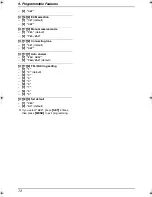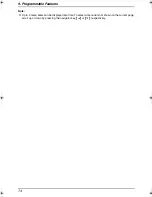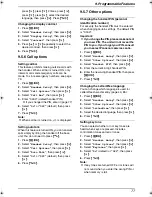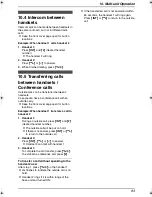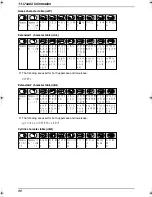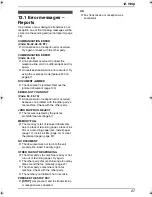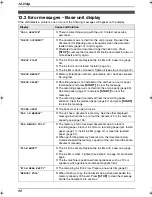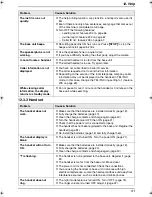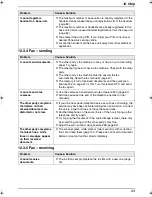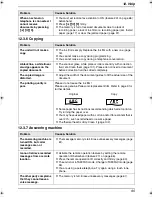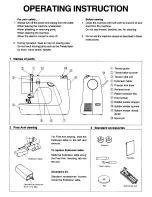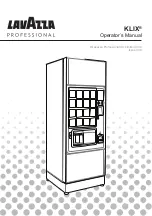
10. Multi-unit Operation
81
10 Multi-unit Operation
Additional Units
10.1 Operating additional
units
10.1.1 Additional handsets
Up to 6 handsets can be registered to a single
base unit. Additional handsets, for example, will
allow you to have an intercom call with another
handset while a third handset is on an outside
call. See page 9 for accessory information.
10.1.2 Additional base units
Handsets can be registered to up to 4 base units,
allowing you to add additional base units and
extend the area in which your handset(s) can be
used. If a handset moves out of range of its base
unit when
“
Auto
”
is selected on base unit
selection (page 81), it will look for another base
unit to make or receive calls. Each base unit
forms 1 radio cell.
Note:
L
Calls will be disconnected when the handset
moves from one radio cell to another.
L
Intercom calls and call transfers are only
possible between handsets in the same radio
cell.
10.2 Registering a handset
to a base unit
The included handset and base unit are
preregistered. After purchasing an additional
handset, register it to the base unit. Ensure that
the additional handset is switched ON. If it is not
ON, press and hold
{ih}
for few seconds to
turn the handset ON.
L
Keep the front cover page open for button
locations.
10.2.1 Easy registration
1
Lift the additional handset and press
{ih}
to put the handset in standby mode.
2
Press and hold
{
LOCATOR
}
on the base
unit for about 3 seconds, until the registration
tone sounds.
3
Place the additional handset on the base
unit. The registration tone continues to
sound. With the handset still on the base
unit, wait until a confirmation tone sounds
and
w
stops flashing.
Note:
L
If an error tone sounds, or if
w
is still flashing,
register the handset manually.
L
If all registered handsets start ringing in step
2, press
{
LOCATOR
}
to stop. Start again
from step 1.
L
Charge the batteries of your additional
handset for about 7 hours before initial use.
L
This registration method cannot be used for
handsets that have already been registered
to a base unit. Register the handset
manually.
10.2.2 Manual registration
1
Press
{j
/OK
}
.
2
Select
“
Handset Setup
”
, then press
{>}
.
3
Select
“
Registration
”
, then press
{>}
2
times.
4
Press and hold
{
LOCATOR
}
on the base
unit for about 3 seconds, until the registration
tone sounds.
L
If all registered handsets start ringing,
press
{
LOCATOR
}
to stop, then repeat
this step.
L
After pressing
{
LOCATOR
}
, the rest of
this procedure must be completed within
1 minute.
5
Select a base unit number, then press
{>}
.
L
This number is used by the handset as a
reference only.
6
Wait until
“
Enter Base PIN
”
is displayed,
then enter
“
0000
”
(default base unit PIN),
then press
{j
/OK
}
.
L
If you changed the PIN, enter it (page 79).
L
When the handset has been registered
successfully,
w
will stop flashing. If key
tones are turned ON (page 77), a
confirmation tone will be heard.
10.2.3 Selecting a base unit
When
“
Auto
”
is selected, the handset will
automatically use any available base unit it is
registered to. When a specific base unit is
selected, the handset will make and receive calls
using that base unit only. If the handset is out of
range of that base unit, no calls can be made or
received.
1
Press
{j
/OK
}
.
2
Select
“
Handset Setup
”
, then press
{>}
.
3
Select
“
Select Base
”
, then press
{>}
.
FC238FX-PFQX2261ZA_en.book Page 81 Monday, June 20, 2005 1:30 PM
Summary of Contents for KX-FC238FX
Page 112: ...110 Notes ...
Page 113: ...111 Notes ...






